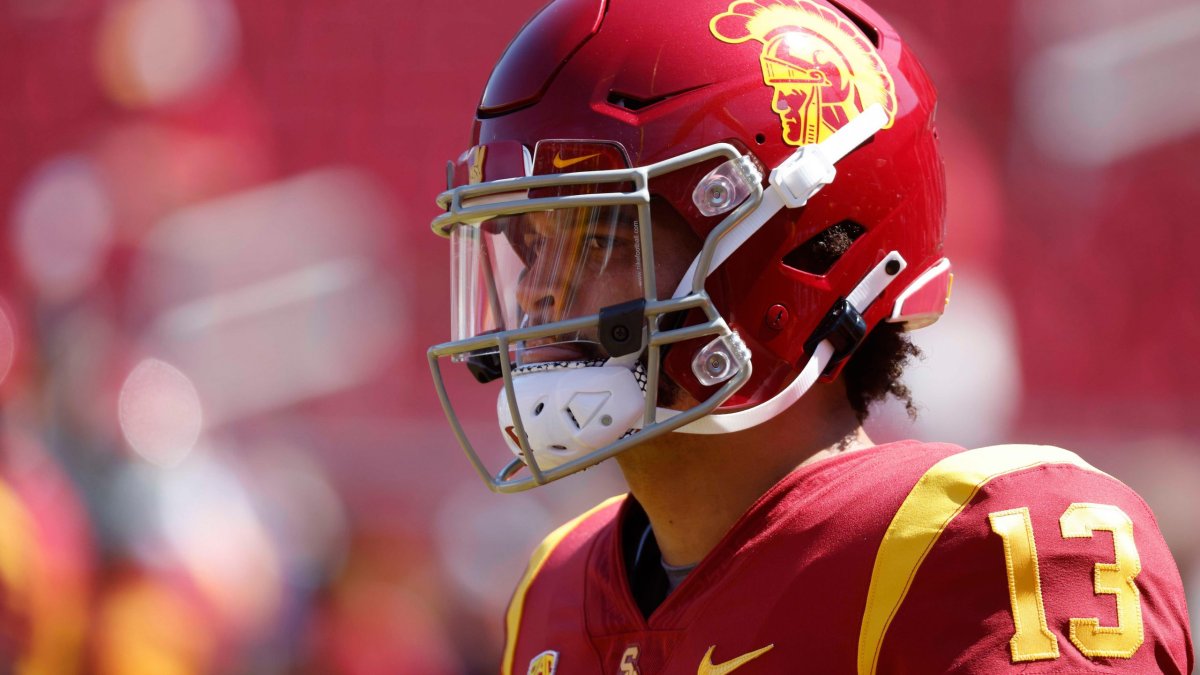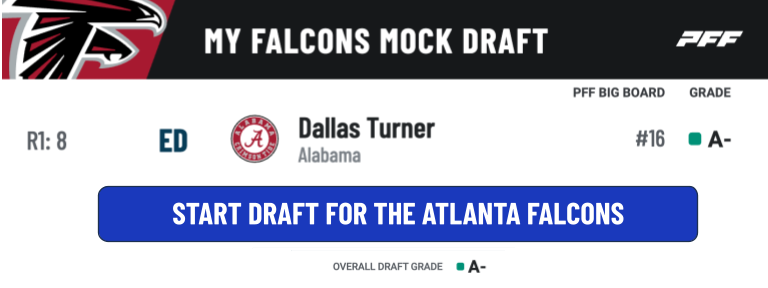• Quarterback is well stocked: Though the gap between Caleb Williams and the field may be widening as we approach the draft, there are four or five other quarterbacks with a legitimate chance to go in the first round, with the second and third players off the board overall likely to be Drake Maye and Jayden Daniels in some order.
• Running back not as stacked as previous years: No back is expected to go in the first round this year, and the top player on the consensus board comes in at No. 60, so a running back going in the second round is no sure thing.
• Draft and trade for yourself: Try PFF's Mock Draft Simulator — trade picks and players and mock for your favorite NFL team.
Estimated reading time: 9 minutes
Click here for more draft tools:
2024 Mock Draft Simulator | 2024 Big Board | 2024 Draft Guide
2024 Player Profiles | 2024 Mock Drafts | NCAA Premium Stats
The 2024 NFL Draft is just a few short weeks away, which brings a huge opportunity to upgrade rosters throughout the NFL.
Some teams will be looking to draft the best players available regardless of position while others will have acute needs that they will be looking to tick off with their first selections.
Either way, understanding the relative strengths and weaknesses of this class is important, so here they are graded by position, on a relatively flattering A+ to C curve.
Quarterback: A-
Caleb Williams is widely seen as a truly elite quarterback prospect, almost certain to be selected No. 1 overall by the Chicago Bears after the team traded away Justin Fields. Williams is generally seen as a prospect that rivals the top player available in most drafts and on his own, he would make this a solid quarterback class.
Though the gap between Williams and the field may be widening as we approach the draft, there are four or five other quarterbacks with a legitimate chance to go in the first round, with the second and third players off the board overall likely to be Drake Maye and Jayden Daniels in some order.
The only real question about this class is the day two and three options, but in a world of all-or-nothing quarterback dynamics, this is less relevant than it once was.
South Carolina’s Spencer Rattler is everybody’s favorite mid-round option, a player whom many are projecting to have legitimate starting ability.
Running Back: C
This is seen as a very weak running back class. If the way the NFL approached free agency at the position is any indication, the league likes the class even less than the general draft community.
Personally, I think the class is better than many other people, but it’s hard to ignore the consensus that it is a weak group, especially coming on the heels of last year where two backs went in the first round.
No back is expected to go in the first round this year, and the top player on the consensus board comes in at No. 60, so a running back going in the second round is no sure thing.
Jonathon Brooks has legitimate tools but is coming into the draft coming off a serious knee injury while there are others with true bell-cow potential. Trey Benson has prototypical tools while mid-round picks spent on Blake Corum, Jaylen Wright, MarShawn Lloyd or Audric Estime could produce immediate-impact players.
Receivers: A+
This is an elite receiver class, even set in the context of a lot of recent very strong draft classes.
The “Big-Three” of Marvin Harrison Jr., Malik Nabers and Rome Odunze would each be the top receiver in most draft classes while the next wave is absurdly deep. There are 23 wideouts or tight ends in the consensus top 100 players, meaning almost a quarter of the best 100 players in this draft are pass catchers.
The depth doesn’t drop off after those early rounds and you can be deep into this group and still come away with receivers that can make an immediate NFL impact.
Offensive Tackle: A
Unlike receiver, there have been very barren years at the tackle position since PFF has been grading college players. That is not the case this season, as several elite prospects are available as well as good depth following them.
Joe Alt has had elite PFF grading throughout his college career and allowed fewer than 10 total pressures in each of his last two seasons. Olu Fashanu is one of the best pass-blockers we have seen enter the league in years, allowing only one knockdown of his quarterback and 16 hurries over the last three years. Taliese Fuaga is a run-blocking monster, Troy Fautanu is an elite athlete who could play tackle or guard, and there are several more potential first-round players as well as significant depth beyond.
Interior Offensive Line: C+
There’s a chance there is only one interior offensive lineman — Oregon’s Jackson Powers-Johnson — gets drafted in the first round. Some of the talk of tackles moving inside to guard from this draft class may also be a reflection of the relative weakness of the pure interior players available.
Troy Fautanu was being talked about as a guard convert until his combine performance showed that he has prototypical tackle measurements and elite athleticism.
To be fair to Powers-Johnson, he is an elite center prospect whose only real question mark is injury history. He allowed four total pressures over the last three years of play, one of which came primarily at guard, and his run-blocking grades were outstanding.
Zach Frazier is another center looking to sneak into the first round, but this draft seems to have a real shortage of pure guard prospects, depending on how you classify Graham Barton, who is being projected inside by most.
The second and third rounds will see most of these interior players taken off the board, making it a thin crop of top prospects.
Defensive Interior: B
Defensive tackle depth has been an issue for the NFL draft for a few years, and Byron Murphy II along with Johnny Newton will be looking to try and address that. Each is likely a first-round pick in this draft while a stellar performance at the Combine could propel Braden Fiske into the bottom of the first round as well.
The second wave of interior players is also solid with Kris Jenkins Jr. and the mammoth T’Vondre Sweat bringing some elite run defense to the table. Those are the only interior players ranked in the top 55 on the consensus big board, but PFF’s big board is also very high on Ruke Orhorhoro, who notched 26 total pressures last season on 235 pass-rushing snaps.
There are a lot of options beyond the top 100 selections, with some good depth at the position later on in the draft.
Edge Defender: B-
There might not be a true superstar edge prospect this year, but there are several very strong options at the top of the draft, and PFF might argue that UCLA’s Laiatu Latu should be seen as a superstar prospect. Latu had a 96.3 PFF grade last season after notching 62 pressures from 304 pass rushes and posting a 26.2% pass-rush win rate. The knock on him has been seen as average athleticism relative to other top pass-rushers, but his PFF GAS (Game Athleticism Score) — a measurement of in-game athleticism using tracking data — puts him in the top percentile and suggests he is a radically better athlete than he is being given credit for.
Jared Verse and Dallas Turner are the other top-tier prospects this year while a solid second tier of prospects is formed by Chris Braswell as well as Chop Robinson and Darius Robinson among others.
The only thing holding this class back is the volume of those top-tier guys available compared to other drafts.
Linebackers: C+
Impact off-the-ball linebackers have become like gold dust in recent years, with a real lack of them entering the draft among the top prospects for a while. This year isn’t much different, as Payton Turner is the most obvious first-round prospect, but none of the group checking in higher than 44 overall on the consensus big board.
Linebackers have seen their role made more and more difficult by the evolution of offenses at the college and professional level over the past decade, and it seems to be creating a rough period for elite prospects entering the league.
There are some solid options as the draft progresses, but none seems to have the ideal composite of tape, production, NFL tools and athleticism.
Cornerback: A
It might not quite be able to match the wide receiver class, but cornerback could be the second-biggest strength of this draft class.
At the top, teams will be split on whether Terrion Arnold, Quinyon Mitchell or even Nate Wiggins is the top player available, but all three are top prospects.
Cooper DeJean, Kool-Aid McKinstry and Ennis Rakestraw Jr. are also all vying to be selected in the first round, and there is depth for days in this class, with 15 total players in the top 100 of the consensus big board.
Safety: C+
This is a solid yet unspectacular safety class. There might not be a first-round player at the position — unless a team decides Cooper DeJean will play there at the next level — but there will likely be a run on them in the second and third rounds of the draft, which tallies with the current valuation of the position overall.
Tyler Nubin is the top-ranked safety on most boards. He had an 89.2 PFF grade last season and had four forced incompletions as well as 10 defensive stops in the run game.
It may be one of the weaker positions in the draft, but there will be solid players to be had in the mid-rounds for teams in need of safety help.






 © 2025 PFF - all rights reserved.
© 2025 PFF - all rights reserved.